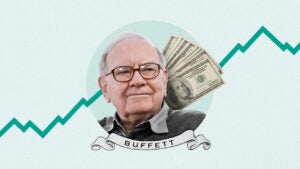4 popular money influencers reveal the best investing decision they ever made

Investing can feel like a huge risk, especially when you’re first starting out. You hear stories of bad investments and crushing stock market volatility, and it’s easy to wonder — what’s the secret to making good investing decisions?
Here’s the truth: There’s no magic formula. But there are proven strategies that set successful investors apart from the rest. The best part is these investing moves aren’t complicated at all — you can make them, too.
Everyone’s financial journey is unique, but some lessons are universal. Here are the best investment decisions of top financial influencers — and how to recreate their top money moves in your own life.
I started early and saved consistently
If there’s one golden rule of investing, it’s start as early as you can.
Time is a superpower when it comes to growing your wealth, thanks to the magic of compound interest. When you invest, your money earns returns. Those returns then generate their own returns, snowballing over time. The longer your money has to grow in your portfolio, the more powerful this effect becomes.
“The best investing decision I ever made was starting at 22, even before I fully understood what I was doing,” says Jannese Torres, an entrepreneur, business coach and founder of the personal finance podcast “Yo Quiero Dinero.”
Torres achieved financial independence in 2021 at the age of 35 when she earned enough from her side hustles to quit her six-figure engineering job. Investing early played a key role in reaching that milestone decades ahead of schedule.
“I kept learning more and investing more as my education and confidence grew,” says Torres.
Growth comes from action, not perfection.
— Jannese Torres Entrepreneur, business coach and podcaster
Consider this: If you invested $200 a month starting at age 22 and earned an average annual return of 8 percent, you could have over $900,000 by age 65 before taxes and inflation.
Start at 35 instead? You’ll end up with just $300,059 — less than a third as much, even though you only waited 13 years.
Investing consistently is equally important. You might not be able to set aside much when you first start out, but slow and steady investments will help you win the race long term.
“Even when I didn’t have a lot of money, I consistently made micro-investments into index funds and ETFs so compound interest could do its job over time,” says Taylor Price, or Priceless Tay, a Gen Z entrepreneur and financial influencer who started investing in college.
Automating your contributions can help make sure you stay on track, whether the market is up, down or sideways. Over time, these regular investments help you take advantage of dollar-cost averaging — buying more shares when prices are low and fewer when prices are high — which can smooth out your returns. It’s like the old adage: Time in the market beats timing the market.
How to implement this strategy
- Contribute to your 401(k): When you start a new job, enroll in your employer’s 401(k) plan right away and contribute enough to receive the full employer match, if one’s offered.
- Set up automatic deposits to an IRA: No employer-sponsored retirement plan? Open a traditional or Roth IRA at an online broker, and set up automatic transfers from your checking account to your IRA each time you get paid.
- Consider low-cost index funds: Instead of stock picking, consider index funds or ETFs that track benchmarks like the S&P 500. These investments are low-cost, diversified and ideal for beginners.
- Take a buy-and-hold approach: Invest for the long term and tune out temporary market swings. Avoid frequent trading to minimize fees, taxes and potential losses.
I stopped letting fear hold me back
Fear is one of the biggest barriers to investing. Whether it’s fear of losing money, uncertainty about where to start or anxiety over market volatility, many people let their emotions keep them on the sidelines.
Chloé Daniels, a full-time financial educator and founder of Clo Bare Money Coach, has attracted a legion of followers on social media by teaching people how to “invest the lazy way” by creating simple portfolios with low-cost funds.
But Daniels says she was terrified to start investing and for years thought she “was just bad with money.”
I kept reminding myself, ‘Dumber people than you have figured it out before.’
— Chloé Daniels Financial educator and founder of Clo Bare Money Coach
“Reminding myself that allowed me to educate myself on how to invest, and get started even when I was scared I’d lose money,” says Daniels.
Here’s the truth: There’s always a risk you’ll lose money by investing, but the bigger risk is doing nothing. Inflation slowly erodes the value of cash sitting in your savings account, while a diversified portfolio has historically outpaced inflation over time.
Overcoming fear doesn’t mean ignoring risk; it means understanding it. Start small if you’re nervous. Consider investing a modest amount in a low-cost index fund or ETF. As you see your portfolio grow, you’ll gain confidence to invest more.
“I messed up in the beginning — picking individual stocks and actively managed mutual funds — but those mistakes were easy to fix once I learned more,” Daniels says.
How to implement this strategy
- Educate yourself: Explore websites, blogs and YouTube channels dedicated to investing. Check out Bankrate’s guide on investing for beginners for an easy-to-follow road map.
- Understand your risk tolerance: Determine how much risk you’re willing to take and align your investments with your goals.
- Practice patience and discipline: Avoid impulsive decisions and stick to your investment plan so you can leave emotions out of the equation.
I didn’t pay off all my debt before investing
Student loan debt is a burden for millions of Americans, so it might be tempting to put all your focus — and extra money — on paying it off as quickly as possible before investing.
But, like the experts earlier emphasized, waiting too long to start investing can cost you significant growth opportunities.
“My second-best investing decision was getting started even when I thought I had too much debt to invest,” says Daniels. “The more I learned, the more I realized that waiting to invest because I’m trying to pay off low interest rate debt first is not the move.”
Imagine your student loans have an interest rate of 3.5 percent. If you can invest in a portfolio that earns an average return of 8 percent, you’re essentially gaining a 4.5 percent net benefit on the money you invest.
Over decades, this opportunity cost of completely paying off debt before investing can add up to hundreds of thousands of dollars in lost wealth.
The key is balance. You don’t have to choose between paying your debt off completely or investing — you can do both.
Experts usually recommend prioritizing high-interest debt, like credit cards, first. But even making minimal contributions to your 401(k) or IRA can significantly boost your net worth over time while keeping your debt under control. Many employers even offer matching contributions for retirement plans.
How to implement this strategy
- Prioritize high-interest debt: If the interest rate on your debt is significantly higher than potential investment returns, focus on paying that down first.
- Minimum payments on student loans: Make sure you’re making the minimum payments on your student loans in order to avoid late fees and penalties.
- Refinance: Consider refinancing your student loans if you can secure a lower interest rate. This can save you significant money over time.
I met with a financial advisor early on
Investing can be intimidating, but you don’t have to figure it out alone. A financial advisor can provide invaluable guidance tailored to your unique situation. They can help you create a plan, set realistic goals and avoid costly mistakes.
In 2023, Shang Saavedra, a financial educator and influencer, accomplished a goal most people only dream of — retiring early at the age of 37.
“My best investment decision was spending $250 when I was 25 years old on a one-hour meeting with a fiduciary financial advisor,” says Saavedra, who founded Save My Cents, a financial coaching business, in 2016.
Notice that Saavedra spoke to a fiduciary. Picking the right type of financial advisor is critical. Unlike some financial professionals, fiduciaries are legally required to put your best interests first. That means their advice is truly unbiased and geared toward helping you succeed, not selling you expensive investments or insurance so they can earn a commission.
“I was very frustrated that I couldn’t find someone I could trust to help validate that I was on the right track,” says Saavedra. “This financial advisor was the first person to let me know I was doing the best thing for my future — investing in broad, low-cost stock funds — and using my 401(k) and IRA to gain some tax advantages.”
The insight you gain from professional advice can save you time and thousands of dollars over the years, making it one of the smartest investment decisions you can make. For Saavedra, the experience was priceless.
“It was so helpful to know I wasn’t doing this alone,” she says.
How to implement this strategy
- Find a financial advisor: If you need help finding an advisor, you can use Bankrate’s free AdvisorMatch to get connected with a certified financial planner in minutes.
- Understand their fees: Ask any potential advisors about the fees you’ll pay and their impact on your returns.
- Consider a robo-advisor: If you need someone to manage your investments, not just provide one-time financial advice, robo-advisors can be an affordable alternative. Platforms like Wealthfront and Betterment can build a custom portfolio based on your goals, and they can rebalance your investments over time.
Bottom line
The best investing decisions aren’t about buying 1,000 shares of the next big tech stock or timing the market perfectly. They’re about creating habits and strategies that set you up for long-term success. The sooner you start, the more time your money has to work for you, so take that first step and watch your wealth grow over time.
Editorial Disclaimer: All investors are advised to conduct their own independent research into investment strategies before making an investment decision. In addition, investors are advised that past investment product performance is no guarantee of future price appreciation.
Why we ask for feedback Your feedback helps us improve our content and services. It takes less than a minute to complete.
Your responses are anonymous and will only be used for improving our website.






